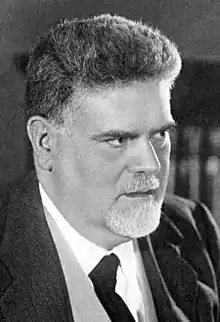The Doctrine of Fascism
"The Doctrine of Fascism" (Italian: "La dottrina del fascismo") is an essay attributed to Benito Mussolini. In truth, the first part of the essay, entitled "Idee Fondamentali" (Italian for '"Fundamental Ideas"') was written by philosopher Giovanni Gentile, while only the second part ("Dottrina politica e sociale", Italian for '"Political and social doctrine"') is the work of Mussolini himself.[1]
| Part of a series on |
| Fascism |
|---|
 |
|

Overview
Although written in 1927 by Mussolini, with the help of Giovanni Gentile, it was first published in the fourteenth volume of Enciclopedia Italiana of 1932, as the first section of a lengthy entry on "Fascismo" (Italian for 'Fascism'). The entire entry on fascism spans pages 847–884 of the Enciclopedia Italiana, and includes numerous photographs and graphic images. The entry starts on page 847 and ends on 851 with the credit line "Benito Mussolini." All subsequent translations of "The Doctrine of Fascism" are from this work.
A key concept of the Mussolini essay was that fascism was a rejection of previous models: "Granted that the XIXth century was the century of socialism, liberalism, democracy, this does not mean that the XXth century must also be the century of socialism, liberalism, democracy. Political doctrines pass; nations remain. We are free to believe that this is the century of authority, a century tending to the "right", a Fascist century. If the XIXth century was the century of the individual (liberalism implies individualism) we are free to believe that this is the “collective” century, and therefore the century of the State."[2] Nonetheless, Jane Soames, in her “authorized translation” of Mussolini’s 1933 ““The Political and Social Doctrine of Fascism” reads: “a century of the Left, a century of Fascism” on page 20.
Translations
The first authorized translation into English was prepared by Jane Soames and published by Leonard and Virginia Woolf in 1933 (The Political and Social Doctrine of Fascism, London: Hogarth Press, 1933). Soames' translation was also published in The Living Age, November 1933, New York City, p. 241, as a chapter entitled "The Doctrine of Fascism".
Other translations include:
- Nathanael Greene, ed., Fascism: An Anthology, New York: Thomas Y. Crowell, 1968, pp. 41, 43–44
- Benito Mussolini, My Autobiography: With "The Political and Social Doctrine of Fascism", Mineola, New York: Dover Publications, 2006, p. 236.
See also
Notes
- De Felice, Renzo (2006). Mussolini il duce (in Italian). 3: Gli anni del consenso, 1929-1936. Turin: Giulio Einaudi editore. pp. 35–36. ISBN 9788806139964.
- Online version
References
- Fascism, Noel O'Sullivan, 1983 pg 138: referencing; Mussolini's Roman Empire, by Mack Smith Penguin, ed., 1979, first published in 1976.
- Mussolini, Benito (1935). The Doctrine of Fascism. Florence: Vallecchi Editore.
- Mussolini, Benito (1935). Fascism: Doctrine and Institutions. Rome: Ardita Publishers.
- Translation of the 1932 Enciclopedia Italiana essay "Doctrines" by Mussolini. This translation is by Mr. I. S. Munro, from "Fascism to World-Power" (Alexander Maclehose, London, 1933). It is part of a 1984 compilation book: Readings on Fascism and National Socialism; Swallow Press, Athens, Ohio, 1984.
- Schnapp, Jeffrey T.; Sears, Olivia E.; Stampino, Maria G. (2000). A Primer of Italian Fascism. University of Nebraska Press. ISBN 9780803292680
- My Autobiography. Book by Benito Mussolini; Charles Scribner's Sons, 1928.
External links
- The Doctrine of Fascism by Benito Mussolini Complete text of the essay "Dottrina" (Doctrines). A translation of the Benito Mussolini "Doctrines" section of the "Fascism" entry in the 1932 edition of the Enciclopedia Italiana. From the publication Fascism: Doctrine and Institutions, by Benito Mussolini, 1935, 'Ardita' Publishers, Rome. Footnote numbers inserted in the text, and a footnote appendix (both not found in the 1932 encyclopedia article), are found in this 1935 publication. The footnotes contain excerpts from his speeches.
- Authorized translation of Mussolini’s “The Political and Social Doctrine of Fascism” (1933)
- Italian text.
- What is Fascism? Quotes from Mussolini and Hitler. English. Includes a few excerpts from another translation into English of the Mussolini essay on "Doctrines" in the 1932 edition of the Enciclopedia Italiana. From The Doctrine of Fascism, by Benito Mussolini, 1935, Firenze: Vallecchi Editore.
- 2 Mussolini autobiographies in one book. English. Searchable. Click on the result titled "My Rise and Fall" (usually the top result). Then use the search form in the left column titled "search within this book."
